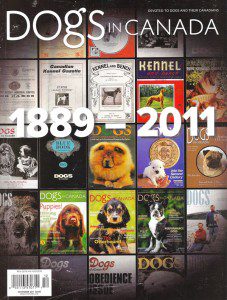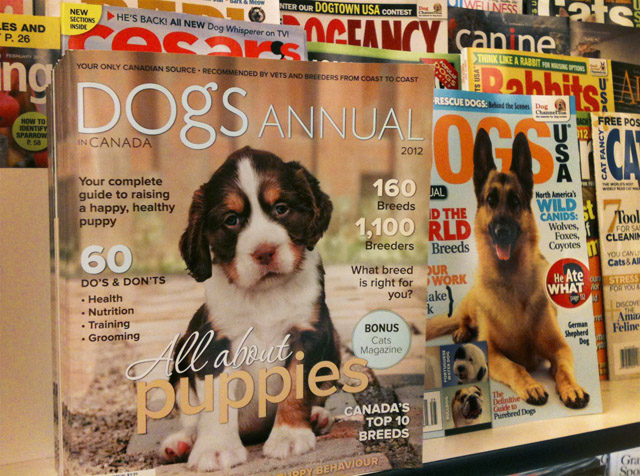Put to sleep
How the fate of Dogs in Canada magazine rested on the board of the Canadian Kennel Club
Kelly Caldwell’s baby had surgery four weeks ago and is on her way to recovery. “She injured her knee and had to have two pins put in,” Caldwell says. Her baby, Dottie, is a year-and-a-half-old Boston terrier that has an appointment with the vet. “She’s going for a little bit of dog physiotherapy today,” Caldwell says.
Her love of dogs doesn’t end with the two she has at home (She also owns a 14-and-a-half-year-old Basenji named Jazz), as the editor-in-chief of Dogs in Canada magazine, Caldwell cared about all dogs. But that wasn’t enough to keep the 122-year-old magazine from being put down after the December 2011 issue hit newsstands.
The longest continuously running consumer magazine in Canadian history, Dogs in Canada comprised a monthly magazine, an annual magazine, and two websites that took pride in informing dog owners about the best ways to care for their pets. There was no room in the magazine for superficial stories like “how to dress your dogs.” There were, however, thousands of words devoted to keeping your pets healthy and cared for. Dogs was run by passionate canine lovers reaching out to like-minded Canadians. In recent years circulation for the niche publication was respectable, so Caldwell says. “We were surprised, on the one hand. But at the same time, we felt like the writing was on the wall some time ago.” Part of the reason for this outcome was the Canadian Kennel Club’s ownership of the magazine.
The CKC was founded in September 1888 when dog fanciers (the term used to describe people who are involved in the world of purebred dogs and shows) wanted their own governing body that was separate from the American Kennel Club. In February 1889, the first issue of The CanadianKennel Gazette was published by the owner of the Canadian Poultry Review. The CKC formally took over in 1912, naming the new publication Kennel and Bench. The name changed to Dogs in Canada in March of 1940 to appeal to consumers.
In 2005, after years of being without an editor, Caldwell—who had a background in writing but was working as a professional photographer—was brought on as the new editor-in-chief. The publisher at the time, David Bell, had made it his mission to get Dogs to the newsstand as a consumer magazine. After much persuasion to the board, he succeeded, and Caldwell was hired to usher in fresh content that would appeal to both pet owners and dog fanciers. Right away, more stories about mixed breed and rescue dogs filled the pages of the magazine.
This shift brought Dogs its highest newsstand numbers. The Annual set sales records in 2007 and 2008. In March 2010, a year before the magazine folded, the circulation of Dogs in Canada magazine hit 47,000. More Canadian dog owners were buying the magazine and relating to the stories. But the reporting on mixed breeds meant less coverage of purebreds, and the Canadian Kennel Club was dissatisfied. Longtime contributor Leslie Smith couldn’t fully understand the issue. “The broader the appeal, the bigger the audience, the more people will see the breeders’ ads,” Smith says. She adds that owners of mixed breed dogs had almost double the reason to buy the magazine. “If you get a boxer/terrier mix, your dog is going to be exhibiting facets of a terrier and facets of a boxer—you’re going to want to know what those facets are. This was the ideal place to talk about these things.” At the September 2010 board meeting, Ann McDonagh, the last publisher of Dogs, was given a directive: the magazine had to go back to reporting exclusively about purebreds. McDonagh had tried to resist the change for more than a year, and told the CKC that financially it was a bad decision. According to McDonagh, the CKC membership was declining every year.
Sonny Allinson, the manager of communications and marketing for the CKC, assured that extensive research within the club’s membership had been done before the decision was made to change the magazine’s mandate. The CKC was not able to provide any official figures from this data. There was no magazine consultant overseeing the changes—the fate of Dogs rested with the APEX board, made up of three CKC board members who had no background in magazine publishing. The Dogs staff began a slow transition back to the old ways, and in January 2011 the editorial direction was once again exclusively purebred. Dogs, according to Caldwell, “lost its heart and soul.” At the same time, the distribution of Dogs to CKC members was also changing. Until 2007, members had been given a subscription to the magazine with their membership fee. In order for the magazine to meet the guidelines given by the Department of Canadian Heritage for the Aid to Publisher’s Grant, McDonagh had to take away this membership perk. Members instead and had to opt in for a subscription.
Consumers not interested in purebred content stopped buying the magazine and purebred fanciers, who were the reason the editorial changed to begin with, failed to subscribe. “It’s hard to know what happened,” McDonagh says. “But our subscriptions dropped by about 40 percent from the members and the only thing that had changed was the editorial.” The distribution for the December 2011 issue was 18,379.
At the September 2011 board meeting, exactly one year after the CKC had forced the mandate of the magazine to change, the board members told McDonagh that Dogs in Canada magazine was ceasing publication. They said that the magazine had no foreseeable growth prospects, but that DogsinCanada.com would remain online and continue to publish new material.
The last issue of Dogs and the Annual appeared in December 2011. McDonagh resigned in October; the rest of the staff was terminated by email days before Christmas. The website was supposed to remain online, but with no one to maintain it, slowly became static, the only new content coming from disappointed readers commenting on old blog posts. The site is now offline. Dottie is recovering. In the right hands, the hands of a caring and responsible owner, she’ll be back in good health in no time. Unfortunately Dogs in Canada, neglected by its owners, didn’t get the same chance.
















